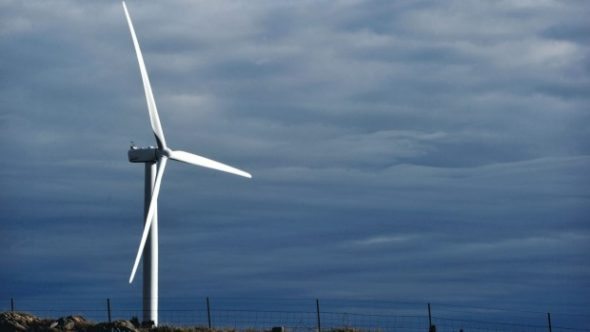Origin Energy has set a stunning new benchmark for renewable energy off-take deals in Australia – and sounded the alarm for energy incumbents – after committing to a long-term power purchase agreement of below $60/MWh for the 530MW Stockyard Hill Wind Farm in Victoria.
Under the terms of the deal, Origin will sell Stockyard Hill Wind Farm – Australia’s largest wind development – to Chinese company and wind turbine manufacturer Goldwind for $110 million.
At the same time it has agreed to buy all of the power generated by it, and the associated Renewable Energy Certificates, for less than $60/MWh, from the commencement of operations in 2019 to 2030.
RenewEconomy understands that the strike price for the wind farm output is “well below” $60/MWh and closer to $50/MWh than $60/MWh.
As such, it sets a new benchmark for renewable energy prices in Australia, and its impact should not be underestimated. It is, after all, around half of the wholesale price and comparable to what could be bought directly from a brown and coal fired generator.
It compares with the AGL deal to pay just $65/MWh for the output of the Silverton wind farm in the first five years, which beat the previous low price of $73/MWh price struck in the ACT wind auction for the Hornsdale wind farm, although that price was fixed for 20 years, with no inflation uplift.
Origin Energy CEO Frank Calabria says it indicates just how fast Australia’s renewable energy transition is unfolding.
“Through our deal with Goldwind, Origin has been able to add a substantial amount of new renewable energy to our portfolio at a market leading PPA price.
“And, as Stockyard Hill is in Victoria, this will help to cover a large portion of the load of the recently retired Hazelwood Power Station,” Calabria said.
“As Origin looks to a future where renewables will dominate Australia’s energy supply, we are in a very strong position to build one of the nation’s lowest cost renewables portfolios.”
Origin has signed a slew of PPAs with wind and solar farms in recent months, including the 110MW Darling Downs solar farm – located adjacent to its large gas generator – which it sold to APA last week. It has also signed contracts for three other solar farms – including the 220MW Bungala solar farm in South Australia and has two more large contracts in the pipeline.
Origin, like the other retailers, are expected to shoulder the bulk of the efforts to meet Australia’s renewable energy target of 33,000GWh by 2020, which roughly equates to around 23.5 per cent of total demand. Origin is indicating that it can go further, courtesy of the plunging cost of wind and solar.
“By 2020, we expect that renewables will be more than 25 per cent of the energy in our generation mix, allowing us to deliver the cleaner energy our customers want,” Calabria said in a statement.
“Last year, we announced our ambition to add up to 1,500MW of new renewables by 2020, and we are now just 300MW short of that target.”
Last week, the Clean Energy Regulator said that despite fears to the contrary, the RET was likely to be met, given the huge rush of contracted projects in the last six months, particularly in solar. It says there may be enough commitments made by the end of the year to meet that target.
Some doubt that, worrying about the retailers’ appetite beyond the current rush of projects, but Origin’s comments appear to allay those fears.
While recent investment has been centred around large scale solar farms, whose costs have fallen dramatically in the last year, the Stockyard Hill deal shows there are still great deals to be found in wind energy, and wind energy costs are still falling.
 It also suggests that Origin will have to update this graph to the right that it released last week, which highlighted the plunging cost of wind and solar PPAs in Australia over the last few years.
It also suggests that Origin will have to update this graph to the right that it released last week, which highlighted the plunging cost of wind and solar PPAs in Australia over the last few years.
Note how Origin make it clear that renewables are the lowest cost new build generation today -it’s not coal, it’s not gas, and it’s certainly not nuclear.
Indeed Origin, like AGL Energy, has now dismissed the idea that gas fired generation can play any significant role in the energy transition, with Calabria telling investors last week that only gas peaking plants will play a role, and that they will be “even peakier” than they have been, suggesting they will be used less and less as more wind and solar and more storage is installed.
The Stockyard Hill deal, announced on Monday, remains subject to regulatory approvals and still hinges on Goldwind achieving financial close of the project.
That financing shouldn’t be an issue, given that Goldwind is one of the biggest wind turbine manufacturers in the world and is currently building the 175MW White Rock wind project in Barnaby Joyce’s electorate, and is building it without a contract and on a merchant basis.
Environment Victoria’s Mark Wakeham said it was clear that the finance industry had decided that renewable energy was the future, but warned that deployment would grind to a halt unless the Turnbull government extended the national renewable energy target and the Victorian government legislated the state renewable energy target.
“To meet our national 2020 renewable energy target, all projects will need to be underway this year or next. After that, investment in renewable energy projects could fall off a cliff without longer-term targets.”
Note: To catch up on last week’s events and RenewEconomy’s analysis you can listen to our Energy Insiders Podcast, click here or below.











